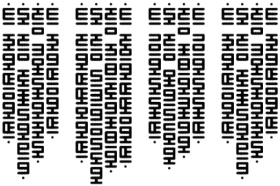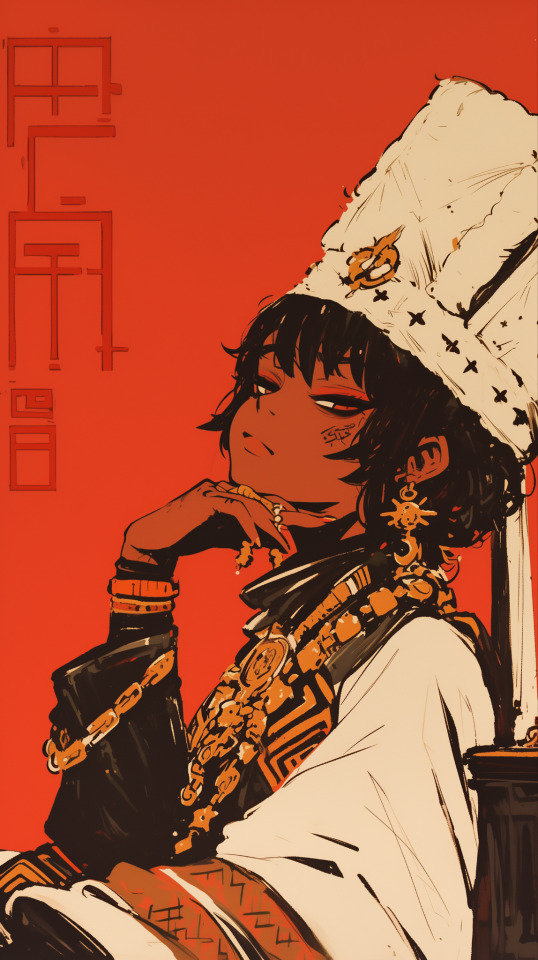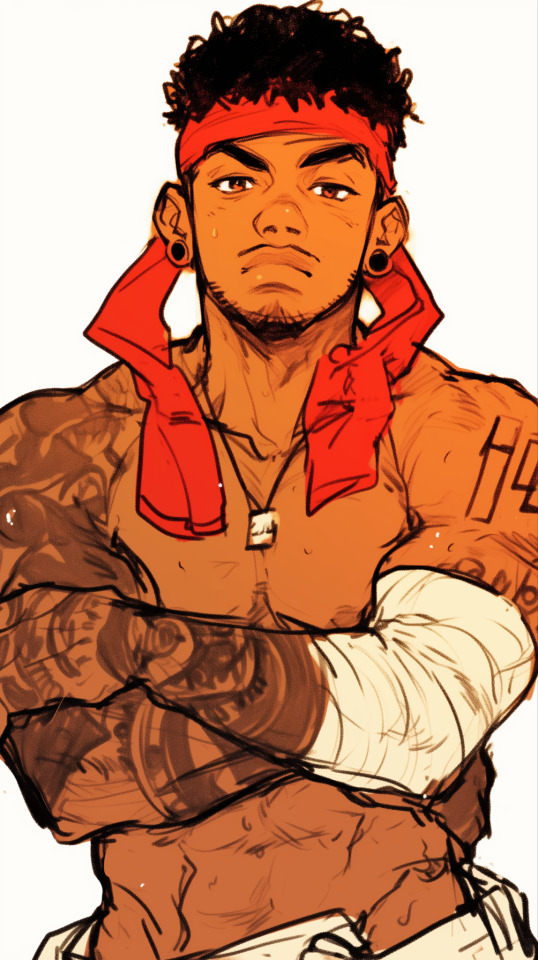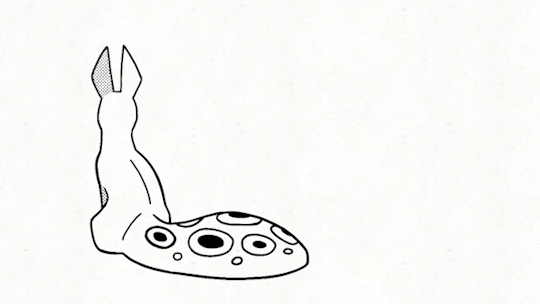Text
I’m making a conlang, and my friends [who have no language experience whatsoever] wanted to do something with it. I let them have ONE singular thing to decide on.
Now my language has a base three counting system. Don’t trust anyone with your languages. Betrayal.
27 notes
·
View notes
Text

a glorious image I made, enjoy
0 notes
Text
All gender is made up but my gender is more made up than yours because I am a conlanger.
223 notes
·
View notes
Text
A history and summary of my conlang
Sequvisk
A polysynthetic language, specifically an agglutinative polysynthetic language, although some members of it’s related language family are fusional instead. Using particles to properly put its ridiculously long words together in a usable order and reduce the need for more clutter, making the words more of a list of objects and then the particles show what is what and how they go together, also marking pronouns and possession within the word. It has a complex system for clause coordination.
Sequvisk comes from an ancient empire which formed speaking an archaic language now known as Sequnes, spread across the archipelago. The empire later splintered into smaller independent states, leaving multiple dialects while Sequnes was used as a diplomatic lingua franca by the nobles in multiple of the independent states, which eventually was passed down to the merchants where it morphed from classical Sequnes into modern Sequvisk for trade and diplomacy purposes and is now spoken primarily by merchants, scholars, adventurers, nomads, and mercenaries, as well as anyone who needs to travel between islands often, it is rarely a first language, as most people have a home dialect, but it is pretty universally understandable between dialects.
a text sample in the alphabet/syllabary

kinda inspired by hangul, written top to bottom, right to left. written here is a poem about nature.
ill probably post more about this conlang in the future, I'm really enjoying how it's going.
#conlang#conlangs#worldbuilding#constructed language#writing systems#conlanging#linguistics#languages
5 notes
·
View notes
Text
I think what I love most about mythology is that the “Trickster God/Spirit” is an archetypical character found in almost every body of folklore. It’s like “Oh, here’s our God of the Sun, our God of the Sea, our God of Fertility, and our God of Being A Wretched Little Gremlin Who Causes Problems On Purpose”
41K notes
·
View notes
Text
50K notes
·
View notes
Text
Do you ever get nervous bc your conlang isn't as naturalistic or as well-thought-out as those of the literal masters of the craft and so that must mean it's Literally Garbage
424 notes
·
View notes
Text
Looking up how many phonemes exist in different languages because I’m that guy and apparently Hawaiian only has 13 phonemes.
I don’t know what to say about that. That’s not a lot. I think it’s cool you can have a language with so few sounds.
2K notes
·
View notes
Text
The Shukwoto Caste System (Part 1)

When the Shukwoto States conquered the Shukweso Continent, they imposed their Caste System upon all the ethnic groups they subjugated (Chukwezi, Ðeodisć, and Fusō).
Everyone is born into a Caste, but some can move up and many downwards
The Ngozidji (The Servants of Ngozimenhaza)
The Ngozidji are the aristocrats. Ethnic Shukwoto Men and Women who descend from the 60 Legendary Heroes who brought the Shukwoto together and began their 500-year conquest of Shukweso.


They have powers given to them by their god Ngozimenhaza and passed down the generations.

Privileges: Only Full or Half Shukwoto People can be in this caste, Can serve as Judges, Full Voting Rights, Can serve in Legislature, Can Contract Djombazi, Priority in employment, Lower Castes must defer to them. Self-Governing and Self-Policing. Freedom of Movement across the entire country.
Restrictions: Cannot marry below Kazibadji.


Ngozidji are known for their arrogance, extreme wealth, and privilege. They control most corporations and run the federal and constituent governments. They're politically extremely conservative and emphasize and celebrate social hierarchy.
They are generally skeptical of egalitarianism.


69 notes
·
View notes
Text



CHENESHT HOMEPLANET - ÂCHLANHTE Star: K-Class, Main Sequence 'Phetchâ' [Petkaa] - Comes from the word for white [Phe] and a contraction of Tlechâ [T'châ - Halo or Radiance. Has godly connotations] Position from Star: Second Axial Tilt: 15 degrees Gravity: .83g Vegetation: Dark Greenish Teal Supercontinent Name: Eshtmhêt [esht-meet] - People Path/People Track Planet Name Meaning: Âchlanhte [Aaklante] - Usually roughly translated as 'All Our Egg'. The name spawns from a Têphecha religious belief that the planet they live on was the first egg laid by one of their gods. Each culture has their own version of this story, but the Têphecha version is the most commonly told to other sophonts.
ETHNICITY NAMES AND MEANINGS
Llalâphe [Lalaape] - Fisher Fenhêalch [Feneelt] - Derived from an old word for Soil [Fenhach] Têphecha [Teepeka] - Stilt or Pole Lhbore [L'bore or Labore] - Large or Tall, sometimes translated as 'Giants' Ôernh [Oorn] - Derived from an old word for Water [Ôrnha] Chlâsle [Tlaasle] - Beader Nhâchchech [Naak'kek] - Weaver
More information under the cut
Âchlanhte's lower axial tilt and lesser gravity cause seasonal patterns to be far more mild than those of earths. The poles barely freeze or melt, the swamps stay wet and humid, and the haze of airborne algae stays easily suspended in the sky, turning it a foggy mint color. The predictable and mild seasons also allowed for easy, early chenesht settling across a vast majority of the Supercontinent's surface which led them to becoming the dominant species, and eventually, the only sapient one.
Some of you may remember This Earlier Post in which I touched a little on natural color variants within Chenesht, consider this the expanded version. Chenesht have 7 distinct ethnic groups which, for the most part, are also their cultural groups. I've covered the Chlâsle and the Nhâchchech briefly before in other posts and plan to eventually go more in depth on the other 5. In terms of cross referencing with the older post, the Chlâsle are the 'standard' coloration, the Nhâchchech are the 'polar' coloration, and the Têphecha are the 'central' coloration. While the colors in this post are still canon, Chlâsle are no longer considered the standard coloration as they're one of 7 ethnicities.
Âchlanhte's supercontinent Eshtmhêt has experienced very little tectonic drift since merging several million years before the dawn of civilization, allowing the various Chenesht cultures to stay socially and technologically connected and up to date with one another throughout their development. It's because of this that all Chenesht largerly speak the same language, with the only differences being slang terms and the occasional differing words between cultures. Each dialect is rougly 90% mutually intelligable with any other, with the Llalâphe and the Ôernh having the most linguistic drift. The 'correct' names for each ethnicity are sometimes debated due to variations on what they're called by themselves vs by others, ie. the Nhâchchech also being called the Eshtchchonh (pattern people) by the Chlâsle. The ones listed here are the popularly accepted proper names.
196 notes
·
View notes
Text

"Friend, there are scavengers watching."
Suns gives Spearmaster a heads up. The text is in my own conlang that I'm using as a Reconstructed Ancient. It reads "!A toganggan .Chiengga mulngjer"
This was originally a practice sketch animation to figure out how to animate quadrupeds but it became a much broader practice piece.
2K notes
·
View notes
Text


New and improved Traveler's Jhabber with a corresponding Traveler's Sign chart as an added bonus. Since half the main cast of Threshold People sign fluently (and one signs exclusively) and Earth plays no part in the universe I've made, I have to make that language from scratch too! Some worldbuilding tidbits under the read more.
Traveler's Jhabber is the official Universal Language of the LIPA (Laurelai Inter-Planetary Alliance), and anyone going through flight certification, from pilots to engineers to diplomats, is required to learn it. Traveler's Sign came a bit later and was also added to the required curriculum, though, unfortunately, most people stop using it once out of the academy unless it serves a practical purpose for them.
Logograms are exclusively for the written form of Traveler's Jhabber. You'll always find a logogram of one of the alien species directly next to proper nouns so you can keep track of who is what, who owns what, and where it all came from. The language-identifying logograms are used less frequently in everyday texts.
262 notes
·
View notes
Text
I am a Clone Wars-era Star Wars fic writer. I've been staring at mando.org for literal years to find slang, fic titles, and nicknames. I once read every entry to make sure I knew all the options for some term or another.
How did I just realize that the Mandalorian word for droid is beskar'ad? Mandalorians literally call droids, "Iron-child".

That is the cutest thing I've ever heard.
2K notes
·
View notes
Text
I've said it before, and I'll say it again: one of the only few bad things about Tolkien's legendarium is that it makes 90% of all other fantasy worlds look either completely or somewhat mediocre in comparison.
Like, what do you mean you don't have a fictional language for your fantasy world? WEAKLINGS
4K notes
·
View notes


